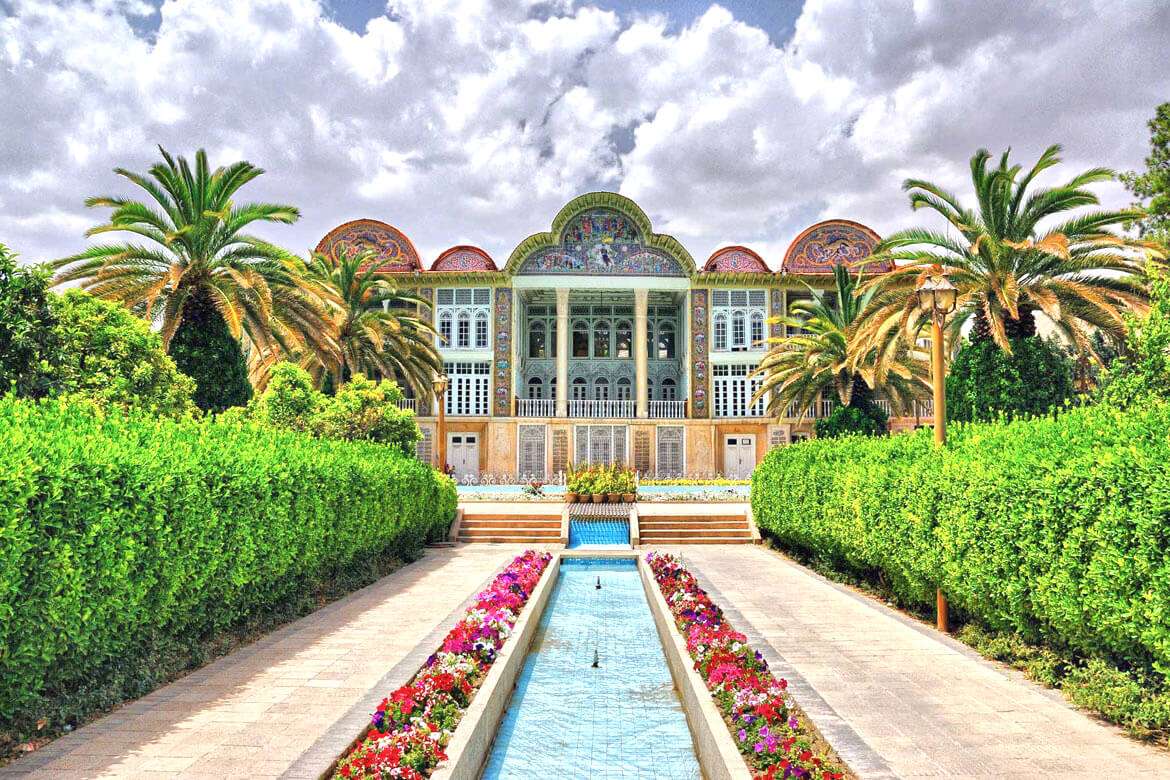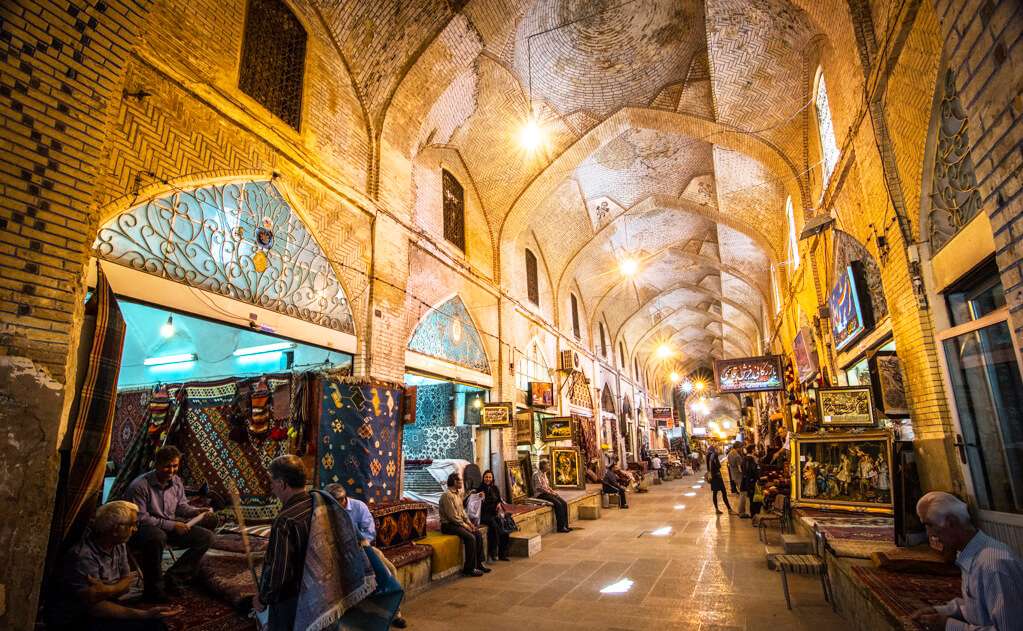Tourist Attractions In Iran
- Route NameTop Places You Must Visit in Shiraz
- ThemeArchitecture/Religious and Epic/Eastern Bazaar
- Duration4 hr(s) and 45 min(s)
Take Glimpses of the History along the Pass Ways of Shiraz
Each monument in Iran reminds of a historical figure or certain historical events. While in Shiraz, one of the top places to visit is Nasir-al-Molk Mosque, built with the command of Mirza Hasan Ali Nasir al-Molk, in the 19th century. Try to go there in the morning so as not to miss the exquisite natural play of lights through the colorful glass. Then stop at Shah-e Cheragh Shrine where Sultan Mir Ahmad, one of the brothers of Imam Reza was buried in the 9th century. Being the chief religious site in Shiraz, Shah-e Cheragh Shrine boasts of remarkable architecture.
Our next stops on this route are the structures built in the 18th century by Karim Khan Zand, the then regent of Iran. The Vakil Bazaar was built in a cross shape plan and contained shops and caravansaries which stand to this date. After Bazaar it is a good idea to visit the 18th century Vakil Bathhouse and the Vakil Mosque. The bathhouse occupies an area of 1,350 square meters and its chambers were designed in a way to prevent the heat from escaping the chambers and cold air from getting in. The Vakil Mosque maintains the basic features of Zand architecture, though it has endured many phases of destruction and reconstruction. The journey through the monuments built by Karim Khan Zand can be completed by a visit to the Citadel. It consists of 12,800 square meter area with four circular towers at each corner. The Citadel was constructed as a fortified residential and administrative area in the center of the city.
- Nasir Al-Mulk Mosque (Pink Mosque)
- Shahcheragh Shrine
- Vakil Bazaar
- Vakil Mosque
- Vakil Bath
- Arg of Karim Khan (Karim Khan Citadel)
- Route NameBest Places on a Day Trip Out of Shiraz
- ThemeArchitecture/Museum/UNESCO Heritage
- Duration5 hr(s)
Over the Footsteps of the Achaemenid Empires
Iran or Persia? Finding the answer will take you on a journey to the deepest pages of the history of this country, which are best manifested by the ruins of the places and cities found out of Shiraz. 50 kilometers from Shiraz, in Marvdasht, you can have a glimpse at true ancient glory and majesty in the ruins of Persepolis. It was specifically constructed to official house meetings and the national religious traditions of Nowruz. Persepolis, the magnificent showcase of Achaemenids, was founded in 518 BC by Darius the Great. Next on this route is the ancient capital city called Pasargadae. Pasargadae was built in 546 BC, on the land that is considered as the homeland of Cyrus the Great and his ancestors. This is a UNESCO World Heritage site filled with the ruins of architecturally notable structures and is famous for housing the Mausoleum of Cyrus. Approaching Pasargadae, the first building that comes to sight is the solemnly standing mausoleum, composed of a high plinth and a tomb-chamber, all in blocks of white calcareous stone.
- Persepolis
- Naqsh-e Rustam
- Pasargadae
- Route NameAn Impressive Tour of Persian Poets in the City of Love & Poetry
- ThemeArchitecture/Relax and Romance
- Duration2 hr(s) and 45 min(s)
A Celebration of Persian Poetry in the Company of Orange Blossoms
Shiraz is the incarnation of poetry and faith in the lush company of flowers and trees. Classic Persian poetry is synonymous with the poetry of Saadi and Hafez. Visit Saadieh, where you will find the tomb of the 12th-century poet in a structure of white marble stone with a turquoise dome, standing in the middle of a beautiful garden. There you can also find the tomb of Shurideh Shirazi, another poet from Shiraz.
More to the north of Shiraz, is the mausoleum of the world-famous 14th-century poet, Hafez. He is the most popular Persian poet who enormously influenced the Persian lyrics. The original structure was built in the 19th century by Karim Khan Zand, and renovated from 1935 to 1937 with the design of French architect, Andre Godard.
In the Allah o Akbar Gorge, you can experience an Iranian tradition of bestowing a blessing upon travelers by passing through the 10th century Quran gate. Overlooking the gate, you will find the Khaju Kermani park, where the Tomb of Khaju Kermani, the 14th-century poet, is located.
- Tomb of Saadi
- Tomb of Hafez (Hafezieh)
- Quran Gate of Shiraz
- Khwaju Kermani Tomb
- Route NameA Romantic Tour in the City of Orange Blossoms (Shiraz)
- ThemeArchitecture
- Duration4 hr(s)
Feel the Orange-Scented Spring Breeze in the Gardens of Shiraz
Thinking of Shiraz, one cannot help picturing beautiful flowers, exquisite gardens, and stately mansions. Start your aesthetic journey in history and culture by stepping into Narenjestan Garden, literally meaning a garden of orange trees. A house-garden from the Qajar period awaits you here. It consists of four buildings serving for residence, undertaking religious rites as well as private and public baths. Follow through this lofty journey in the Eram Garden which was built in the 13th century and has undergone many phases of renovation so as to stand in its dreamy state in the middle of a 12-hectare botanical garden, housing peculiar flowers, and trees. Keep on the route of the rich gardens and eloquent houses by visiting the Afif Abad Garden. Afif Abad or Golshan Garden dates back to the Safavid era but owes its eloquence to the Qajar period. You will be marveled by the combination of Achaemenid, Sassanid and Qajarid architectural characteristics touched by European styles. All of these historical mansions house unique museums.
- Narenjestan Qavam House
- Eram Garden
- Afif-Abad Garden
- Route NameTop 5 Tourist Attraction of Shiraz in Zand Era
- ThemeArchitecture/Religious and Epic/Eastern Bazaar
- Duration3 hr(s) and 45 min(s)
Top 5 Tourist Attraction of Shiraz in Zand Era
The reign of Zand dynasty over Iran in the second half of the 18th century was mainly characterized by its benevolent founder Karim Khan. After Karim Khan’s failure to revive the lost authority of the Safavid dynasty, he defeated his rivals and took the country under his control.
Karim Khan Zand was a just ruler who cared about his people. To show his mercy towards his people, the charismatic ruler entitled himself as “the advocate of his people” instead of “king of kings”. Through well-intentioned efforts, he managed to build a close alliance between the tribes and nobles of major cities in the west and south of Iran. He succeeded to take back the Iranian territories occupied by the Ottomans, from Azerbaijan and Armenia to some parts of Iraq and tried to bring back the prosperity and authority of the Safavid era to the country.
Karim Khan declared Shiraz as his capital in 1766. He chose this city as the seat of his power due to its defensive features, moderate climate and its location on the trade road to the south. Unquestionably, his 30 years of the ruling (1751-1779) constituted the glorious time of the Zand dynasty’s reign over Iran. In 1792, Aqa Mohammad Khan, from the Qajar family, attacked Shiraz, destroyed the battlements around the city and extinguished the light of the Zand dynasty.
Art and Architecture in the Zand Era
Karim Khan’s patronage of art and culture and his efforts to stabilize the political and economic status of the country led to the emergence of exemplary manifestations of art. He had a taste in literature and was a skilled carpet weaver. During the relatively short interval between the rise and fall of the Zand dynasty, the Persian carpet industry continued to prosper and managed to produce designs and features which are unique to this period. The evolution of new carpet designs, such as floral patterns, is evident in the carpets of the Zand period. The prime example of these carpets is the millefiore carpet which is now kept at the Victoria and Albert Museum of London. In fact, the art of carpet weaving flourished across Iran so much that representatives of the East India Company who visited Iran in the late Zand era (the late 18th century) praised the quality of Khorasan carpets and the abundance of Persian rugs in Bushehr. The German traveler, Carsten Niebuhr, who traveled to the south of Iran during the reign of Karim Khan, has finely described “a large and beautiful carpet” which was spread out on the floor of the royal hall to which he was invited.
Persian miniature, especially the Shirazi style of gilded gol-o-morgh, evolved during the Zand period. Abo al-Hassan Ghaffari, Ali Ashraf, Mirza Baba, Bahram Shirazi, and Agha Sadegh are among the best-known painters in this period.
The splendid art of marquetry, for which Shiraz has won great fame, reached its apogee during the Zand era. A teak box kept at the shrine of Imam Ali in Najaf represents the prime example of this art crafted in Shiraz.
The 44-year reign of the Zand dynasty extended the flourishing architecture and decorative arts of the Safavid era. It bridged the traditional Iranian-Islamic architectural style of the Safavids (early 18th century) to the modern style of Qajars (19th-century).
The traces of functionalism in the architectural style of Zandieh are evident in the classic buildings built in Shiraz during this period, constructed based on the four principal elements of Iranian-Islamic architecture: the mosque, the bazaar, the school, and the governmental citadel. The most famous monuments built or renovated in Shiraz during the Zand period are Shahi Grand Square, founded in the northwest of Shiraz and surrounded by Nazar Garden and Divan-Khaneh edifice; The Royal Citadel (Arg-e Karim-Khan); the striking Vakil complex with its bazaar, caravanserai, and wonderful bath; a splendid mosque in Darb-e Shahzadeh quarter; the landmark citadel of Karim Khan and its flanking edifice called Divankhaneh; the iconic tomb of Hafiz, the adjacent Cheheltan garden and Hafttanan garden-museum; Jahannama garden and Nazar garden. Compared with the monuments of the preceding and succeeding eras, the Zand architecture followed simplicity in structure. After the Zand dynasty, western elements were incorporated into the Iranian-Islamic architectural style. Currently, sixteen out of twenty-seven constructions attributed to Karim Khan Zand are standing on their feet in Shiraz.
- Arg of Karim Khan (Karim Khan Citadel)
- Nazar Garden
- Vakil Bath
- Vakil Mosque
- Vakil Bazaar
.jpeg)

.jpeg)


